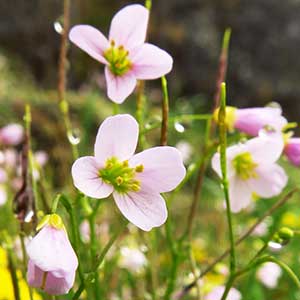Cardamine pattersonii
Cardamine pensylvanica
Saddle Mountain bitter-cress
Pennsylvania bitter-cress, pennsylvanian bitter-cress, Quaker bitter-cress
cylindrical, slender, 0.5–1.5 mm diam.
absent.
(simple from base), erect, (not flexuous), unbranched or branched basally, 0.6–3 dm.
(simple from base), erect, (not flexuous), unbranched or branched distally, (0.5–)1.5–5.5(–7) dm.
rosulate or not, 3 or 5-foliolate, 1–6 cm, leaflets petiolulate;
petiole 0.4–2.5 cm;
lateral leaflets similar to terminal, considerably smaller;
terminal leaflet (petiolule 0.1–0.4 cm), blade obovate to orbicular or subcordate, 0.3–1.5(–2.0) cm × 2.5–16(–18) mm, base obtuse to rounded or cordate, margins entire or dentate to slightly sinuately lobed.
(soon withered), not rosulate, similar to proximalmost cauline leaves, 4–15 cm.
2–4, 3 or 5-foliolate, blade similar to basal, gradually reduced in size as bract, distalmost ones subtending pedicels of flowers (usually simple);
leaflet blade or bract linear to linear-oblanceolate, 0.2–0.8 cm.
(3–)5–20(–35), pinnately (5 or) 7–13(–19)-foliolate, sometimes appearing pinnatisect, lobe number similar to leaflets (middle and proximal ones 2–11 cm), petiolate, leaflets petiolulate, subsessile, or sessile;
petiole (0.4–)1–3.5(–4.5) cm, base not auriculate, (often sparsely hirsute);
lateral leaflets shortly petiolulate or sessile, (decurrent on rachis smaller than terminal, distalmost blades narrower, with fewer lobes or leaflets), margins entire or crenate;
terminal leaflet (subsessile or petiolule to 1 cm), blade suborbicular, obovate to oblanceolate, or elliptic, 1.3–3(–4) cm × 6–25 mm, base often cuneate, margins entire, repand, or obscurely 3 or 5-lobed.
bracteate throughout.
ebracteate.
sepals oblong, (2–)3 × 0.7(–1) mm, lateral pair not saccate basally;
petals purple or pink, obovate, 6–9 × 3–4 mm, (not clawed);
filaments: median pairs 3–3.5 mm, lateral pair 2–2.5 mm;
anthers oblong, 0.7–1 mm.
sepals oblong, (1–)1.3–2.3 × 0.5–1 mm, lateral pair not saccate basally;
petals white, narrowly spatulate to oblanceolate, 2–3.5(–4) × 0.8–1.5 mm, (not clawed);
filaments: median pairs 1.5–2.5 mm, lateral pair 1–2 mm;
anthers ovate, 0.2–0.3 mm.
divaricate-ascending, (10–)15–30(–45) mm.
divaricate-ascending, (3–)4–10(–13) mm.
linear, (torulose), 2–3 cm × 1–1.5 mm;
ovules 14–20 per ovary;
style 2–4 mm.
linear, (torulose), (1.4–)1.7–2.7(–3.2) cm × 0.8–1.1 mm;
ovules 40–80 per ovary;
style 0.5–1 mm.
brown, oblong to ovoid, 1.7–2.2 × 1–1.5 mm, (winged distally).
brown, oblong to ovoid, 0.7–1.1 × 0.5–0.8 mm.
= 32, 64.
Cardamine pattersonii
Cardamine pensylvanica
Of conservation concern.
Cardamine pattersonii is known from Saddle Mountain and Onion Peak in Clastop County.
(Discussion copyrighted by Flora of North America; reprinted with permission.)
We have not seen material of Cardamine pensylvanica from Nebraska or South Dakota; it is very likely that the species grows in these states as well.
(Discussion copyrighted by Flora of North America; reprinted with permission.)
- Local floras:
BC,
CA,
OR,
WA
- Local Web sites:
CalFlora,
CalPhotos,
Flora NW,
Go Botany,
IL Wildflowers,
KS Wildflowers,
LA Plants,
MD Biodiversity,
MI Flora,
MN Wildflowers,
MO Plants,
PNW Herbaria
WildflowerSearch
iNaturalist (observations)
USDA Plants Database
- LBJ Wildflower Center
- SEINet
- Plants of the World Online
- Encyclopedia of Life
- Wikipedia
- Google Image Search


